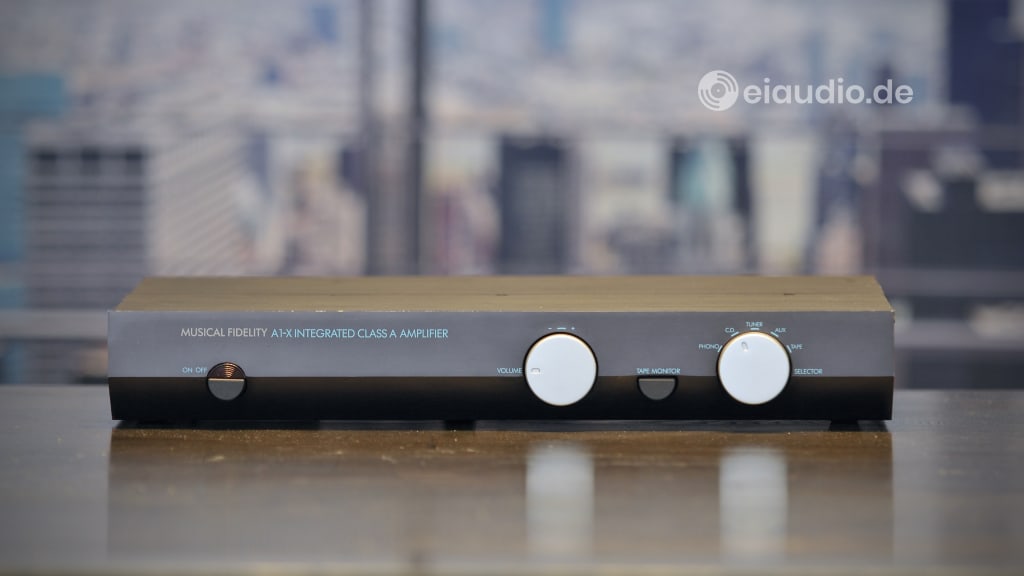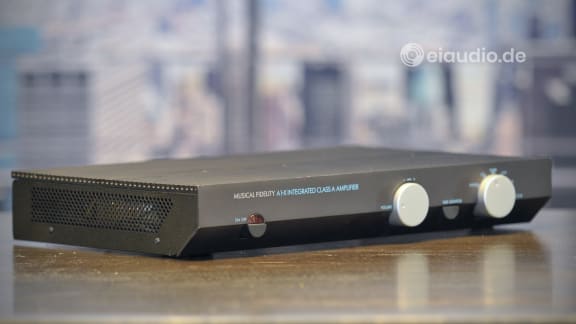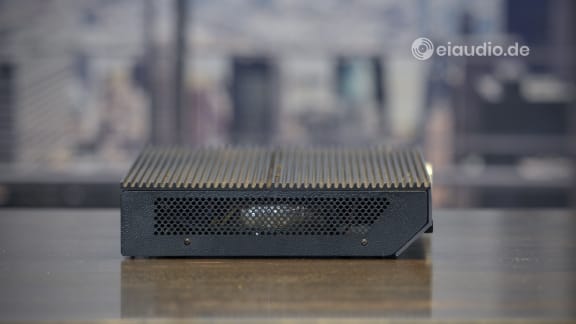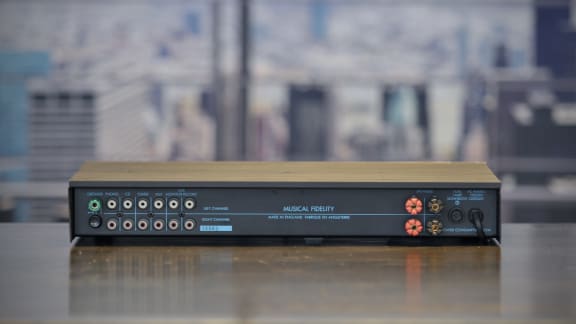Musical Fidelity A1-X
04/07/2022
Author: Karsten Hein
Category: Gear & Review
Tag(s): Integrated Amplifiers
Following the Japanese Luxman L-10 and the Italian Fase Performance 1.0, the British Musical Fidelity A1-X was my third integrated amplifier. It was handed to me for review by my namesake Karsten from Bad Vilbel (north of Frankfurt), who had recently transitioned to a whole set of Naim components to power his Altec speakers. The A1-X had been sitting in storage, until Karsten suggested that I could take it home for review.
Looking at the power rating of 25 watts per channel, I thought it best to hook the A1-X up to our system in the main listening room, which still had the Shure 701 Pro Masters set up. Rated at 102dB, the Shures would be forgiving of a slight lack of power on the side of the amp. However, when I tried to set up the A1-X in place of our Dynaco PAS-4 tube preamp and Hafler XL280 amplifier, I realised that I would need a preamp output to provide music to the subwoofer. In keeping with most integrated amp designs of the 80s, the Musical Fidelity did not offer this connectivity feature.
When considering our second system for compatibility, I was reminded that this had only recently transitioned from the more sensitive Tannoy XT8f speakers to the Epicure EPI 500 which had a modest sensitivity of just 88dB. Would this be enough to be powered by the A1-X? Well, there was only one way to find out. And so, I carried the small Musical Fidelity amp upstairs and disconnected our Restek V1 preamp that had been running to my great delight with our Dynavox VR-70 tube amplifier.
On paper, the change from a 35 watts to a 25 watts amplifier may not seem like a big deal. And yet, 35 watts of tube power were a completely different story, especially in comparison with transistor power. I meanwhile had lots of experience listening to the Restek & Dynavox combo and especially enjoyed its ability to develop the music from the bass notes rising upwards. This is a characteristic that tube amplifiers manage to do so well. In Hi-Fi forums and reviews, I had read that the A1-X was capable of a ‘tube-like’ sound, and I was eager to find out just how much truth there was to this claim.
I began my explorations by listening to Tony Bennet & Diana Krall’s 2018 album ‘Love is here to stay’. This album’s timbre was a bit darker than was typical for Diana’s other albums (with the obvious exception of ‘Rag Doll’, which turned out to be a slip in many ways). While being rich in musical information, ‘Love is here to stay’ had a strong centre-stage focus with channel separation being of less significance. There was lots of natural bass from the instruments but also from the performer’s feet moving and stomping on the floor.
While the technical specifications of the Musical Fidelity A1-X my not seem impressive on paper: 25 watts per channel, 0.5% total harmonic distortion, 80 decibels of signal-to-noise ratio, the A1-X sounded neither weak nor distorted. On the contrary: My initial impression was that this was a perfectly clean sounding amplifier. There was lots of tight control, even when the amp was still heating up. For the first couple of minutes, I had a slight sensation of a channel imbalance and was wondering what was causing it, especially since I had taken extra care not to move the speakers. However, this imbalance disappeared after 3-5 minutes and may have had to do with the preamplifier taking power from the right channel, as was described in Mark Hennessy’s exceptional essay on the A1 and its derivatives. (Have a look for it, it is worth reading.)
Having been freshly connected to phono, the CD player, and the Epicure speakers all at the same time, the A1-X sounded a bit thin at first. Given some time to settle in, however, this impression changed. I appreciated the fact that the Musical Fidelity proved to be tonally accurate with lots of natural timbre. Where the Dynavox tube amp had laid timbre on quite thick, smothering the listener with tonal colours, the A1-X kept it strictly real. In this aspect, it was closer to the more balanced-sounding Luxman L-10 integrated than it was to vintage tube gear.
Imaging was accurate, but instruments seemed slightly more recessed and smaller with more well-defined space around them than I was used to. This tendency became more apparent when I changed over to the 2Cellos 2012 album by the name of ‘In2ition’. It was in moments that demanded superior dynamics and authority that an increase in loudspeaker sensitivity would have produced better results with this integrated amplifier.
The A1-X was the European version of the A1 and released to the public in the mid-1980s. Just like the A1, the A1-X was based on an electronic design created by Hi-Fi legend and long-time Musical Fidelity engineer Tim de Paravicini. The European version already featured the revised design with open cooling vents on both sides. At the same time, the top-cover consisted of two large heat sinks that would easily reach temperatures of exceeding 60 degrees Celsius. The front controls were designed in a way to facilitate accidental touching of the heat sink, which only served to highlight the fact that there was some robust power handling involved.
As Mark Hennessy pointed out, it has been discussed with some controversy just how much power this amp was able to produce. In conducting some measurements and applying basic mathematics, Mark arrived at the conclusion that the A1-X produced an output of 8 watts in class-A before switching to A/B operation. Some, including the designer Tim de Paravicini himself, argued that class-A power output should be calculated differently, in that it more resembled that of tubes in a push-pull design. This would have placed class-A output at closer to 16 watts per channel and served to explain the amp’s continuous power consumption of 90 watts. Another such indication was that heat sink temperatures had been reported to fall by 10 centigrade at full output capacity. Fearing for our speakers, I decided not to confirm these measurements myself.
Mark measured that the output stage was biased at around 800mA, which was quite high, and did at times lead to thermal problems, especially on the first units that were sold without side ventilation. Similar to the Fase Performance 1.0, the Music Fidelity A1-X only offered the most essential controls: an input selector, a volume control, one power and one tape-monitor switch. In this context, it is noteworthy that the A1-X’s phono stage offered enough clean amplification for MC phono cartridges. The internal preamp was able to produce 200mV in gain. An additional switch in the back of the unit allowed owners to switch between MC and MM operation. The quality of the phono stage and the ability to switch to MC would have made the A1-X an instant favourite with audiophile listeners. It was sometimes reported that the large amount of gain on the preamp could lead to unwanted noise, although I did not notice any such issues myself.
Similar to the Fase Audio, the A1 series used a toroidal transformer as power supply. Following the transformer, the amplifier was of a double-mono design, with components mirrored along the central power rails that were supporting the heat sinks. There were a number of smaller facelifts in the versions of this amp from 1984 to 1990, starting with the A1 and the A1-X, which was succeeded by the MKII. There was also a version called ‘David’ that was made (and tuned) for Germany, and a ‘Final Edition’ which featured a MOS-FET output stage. The early designs had their power supplies built inside the main amplifier housing, whereas later specimens featured external supplies that increased power output to nearly 50 watts per channel.
In his discussion of the A1 amplifier, Mark explains that this design was not made to be worked on excessively. Not only was the cabinet too small to house bulky components (the power supply caps were laid sideways to account for the limited height), the large heat sinks were also tricky to remove, with lots of fresh thermal paste being needed on repositioning the sinks. It seemed that some portion of the A1-X’s superb sound quality could be attributed to its simple amplifier design philosophy of 'less-is-more'. Although the amp used some higher quality parts, the output devices themselves were relatively standard for the time: a set of 2N3055/MJ2955. Mark suggests replacing them with more durable Motorola MJ15003 and MJ15004, if they should ever be in need of repair. Later versions of the Motorola transistors (e.g. MJ15022) could also be found on the Fase Audio Performance 1.0, if I recall correctly.
When I was first handed the A1-X for review, Karsten told me about an issue that he had experienced with the volume attenuator having become unpleasantly noisy, but on the day of my arrival, he had not been able to reproduce the phenomenon. This reminded me of a similar issue I had once had with our DB Systems DB 1 preamplifier. In the case of the DB1, there had been a slight amount of DC current running through the quality Alps attenuator during line operation. I believe this stemmed from a broken part on the side of the CD player which resulted in the current. It was quite possible that the reason for the volume control having been noisy on that occasion had been the result of a similar issue with an external device, although Mark did suggest that the A1 design also encouraged small amounts of DC current to pass though the Alps control.
In any case, the Alps Blue potentiometer that was used on the A1-X was also built into the Fase Performance 1.0 to positive affect and did have a good name in audiophile circles. The combination of internal preamp and power amp section served to create the A1-X’s specific sound characteristics. However, it was the high gain of the preamp that also led to the lower-than-average signal-to-noise ratio of 80dB. As, during my listening tests, I did not detect any noise and could appreciate the sonic characteristics of the amplifier, I would be inclined to leave the A1-X in its current configuration. The relatively large amount of class-A amplification made the A1-X an excellent companion for higher sensitivity speakers.
Musical Fidelity Company History
Musical Fidelity is a British Producer of high-end audio equipment with a long line of amplifiers, ranging from power amps via phono and headphone amplifiers to integrated amps (such as the A1), and pre-amplifiers. When the company was founded in 1982, their first product was called “The Preamp”. It already featured an MC/MM switch. The founder, Antony Michaelson, was a clarinettist and Hi-Fi enthusiast who had a knack for unconventional industrial design.
Musical Fidelity’s second product was the “Dr Thomas” power amplifier that bore the name of its designer Dr Martin Vaughan Thomas. With a formidable output of 100 watts per channel, the Dr Thomas amplifier was already quite a beast for a first design. Among the designs that followed, not few went on to become genuine Hi-Fi milestones.
The A1 and all its variants and successors were designed by Tim de Paravicini who died in December 2020. Tim had been friends with Antony Michaelson since 1978 and also through the time when Michaelson was a partner with Michaelson & Austin. In the grassroots fashion of many start-ups, Tim de Paravicini had built the prototype design for the A1 in the private workshop of his home. He was proud to show his invention to Antony Michaelson who had in turn just started Musical Fidelity. Following a difficult time of further development of the design, the A1 would become one of Musical Fidelity's highly regarded products.
Specifications
- Type: integrated stereo amplifier
- Features: high class-A output
- Power output: 2x 25 watts, 8Ω (stereo)
- Class-A output: 8-16 watts, 8Ω (stereo)
- Power consumption: 90 watts continuous
- Frequency response: 20 Hz to 20.000 Hz
- Output stage transistors: 2N3055/MJ2955
- Total harmonic distortion: 0.5%
- Volume control: Alps Blue attenuator
- Inputs: (3x) line, (1x) tape monitor, (1x) phono
- Sensitivity (phono): 0.2mV (MC), 2mV (MM),
- Sensitivity (line): 200mV
- Output terminal: 1-set (bananas/spades)
- Signal to noise ratio (phono): 55dB (MC), 60dB (MM),
- Signal to noise ratio (line) 80dB
- Surface temperature: 55-65 degrees Celsius
- Weight: 5.8 kg
- Dimensions: (W) 408mm ; (H) 68mm ; (D) 258mm
- Year: 1984 - 1992





